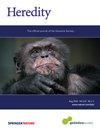欧洲山毛榉种群沿海拔梯度的遗传多样性和精细尺度空间遗传结构
IF 3.9
2区 生物学
Q2 ECOLOGY
引用次数: 0
摘要
环境条件的差异可以影响种群间和种群内种内遗传变异的水平和分布。海拔梯度在短空间尺度上表现出强烈的环境条件变化特征,为研究遗传多样性的空间分布提供了理想的环境。为此,本文以罗马尼亚喀尔巴阡山脉5个欧洲山毛榉(Fagus sylvatica L.)居群为研究对象,在海拔约550 ~ 1450 m的海拔梯度范围内,对其遗传多样性、精细尺度空间遗传结构(FSGS)和春季物候(芽裂)特征进行了研究。利用微卫星和全基因组单核苷酸多态性(SNP)标记,我们观察到遗传多样性随着海拔的升高和群体分化程度的降低而略有下降。此外,FSGS水平沿坡度随海拔升高而降低。我们没有发现春季物候性状对FSGS水平的显著影响,这可能是因为许多不同的环境因素和过程在多年的变化中对FSGS的形成起着重要作用。高海拔种群的遗传多样性略低,可能是由于边缘生态条件和山毛榉丰度较低所致。然而,在这些树冠竞争较少、森林结构更开放的林分中,风媒传粉物种的花粉传播范围可能更长,这可能导致FSGS较弱。了解沿环境梯度的遗传变异水平和结构对森林和保护管理至关重要,特别是在面临气候变化的情况下。本文章由计算机程序翻译,如有差异,请以英文原文为准。

Genetic diversity and fine-scale spatial genetic structure of European beech populations along an elevational gradient
Differences in environmental conditions can shape the level and distribution of intraspecific genetic variation between and within populations. Elevational gradients are characterised by strong variation in environmental conditions on a short spatial scale and provide an ideal setting to study the spatial distribution of genetic diversity. Therefore, we investigated the genetic diversity, fine-scale spatial genetic structure (FSGS) and spring phenology (bud burst) as a proxy for flowering of five European beech (Fagus sylvatica L.) populations along an elevational gradient, ranging from about 550 m to 1450 m a.s.l. in the Romanian Carpathians. Using microsatellite and genome-wide single nucleotide polymorphism (SNP) markers, we observed a slight decrease in genetic diversity with increasing elevation and low population differentiation. Furthermore, levels of FSGS decreased with elevation along the gradient. We could not detect any significant effects of spring phenological traits on the level of FSGS probably because many different environmental factors and processes vary over the years and contribute to shaping the FSGS. The slightly lower genetic diversity in high elevation populations may indicate stronger drift effects and could be due to the marginal ecological conditions and the lower abundance of beech. However, in these stands with less competing crowns and a more open forest structure, pollen dispersal might be longer ranging in this wind pollinated species which could contribute to a weaker FSGS. The knowledge about the level and structure of genetic variation along environmental gradients is crucial to inform forest and conservation management especially in the face of climate change.
求助全文
通过发布文献求助,成功后即可免费获取论文全文。
去求助
来源期刊

Heredity
生物-进化生物学
CiteScore
7.50
自引率
2.60%
发文量
84
审稿时长
4-8 weeks
期刊介绍:
Heredity is the official journal of the Genetics Society. It covers a broad range of topics within the field of genetics and therefore papers must address conceptual or applied issues of interest to the journal''s wide readership
 求助内容:
求助内容: 应助结果提醒方式:
应助结果提醒方式:


